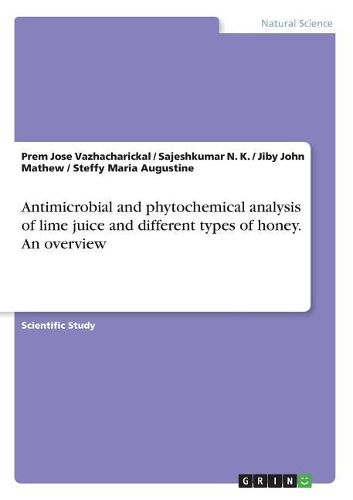Readings Newsletter
Become a Readings Member to make your shopping experience even easier.
Sign in or sign up for free!
You’re not far away from qualifying for FREE standard shipping within Australia
You’ve qualified for FREE standard shipping within Australia
The cart is loading…






Scientific Study from the year 2016 in the subject Biology - Micro- and Molecular Biology, grade: 1.5, Mar Augusthinose College, language: English, abstract: Citrus, one of the major genes of Rutaceae family and most economically important fruit tree and widely cultivated throughout the country. The Citrus have high nutritional value and medicinal value. Honey and lemon-honey are traditional remedies in the Middle East and China and for many centuries and have been used in the treatment and prevention of the common cold and various upper respiratory tract infections. Three types of honey were collected; ‘Cheruthen’-produced by bees belongs to the Trigona irridipennis species; Vanthen’- produced by bees belongs to the Apis indica species; ‘Kattutthen’- produced by bees belongs to the Apis dorsata species. The antibacterial activites of honey samples and lime juice were tested aganist Bacillus, Klebsiella, E.coli, Staphylococcus and Micrococcus. The result showed that the samples have differnt antimicrobial activity. Antimicrobial activity of Cheruthen against Klebsiella species showed a zone of inhibition of 10.1 0.73 mm, when 100 l of Cheruthen is applied. When 200 l of Cheruthen is applied the zone of inhibition was 30.1 0.23 mm. Antimicrobial activity of Cheruthen against E.coli showed a zone of inhibition of 10.1 0.13 mm, when 100 l of cheruthen is applied. When 200 l of cheruthen is applied the zone of inhibition was 30.2 0.23 mm. Also the phytochemical examination of lime juice and honey samples showed that different types of phytochemical substances are present in both lime juice and different types of honey samples. Further studies are required to reveal the role of each phytochemical and its contribution to the antimicrobial properties of the samples included in this study.
$9.00 standard shipping within Australia
FREE standard shipping within Australia for orders over $100.00
Express & International shipping calculated at checkout
Scientific Study from the year 2016 in the subject Biology - Micro- and Molecular Biology, grade: 1.5, Mar Augusthinose College, language: English, abstract: Citrus, one of the major genes of Rutaceae family and most economically important fruit tree and widely cultivated throughout the country. The Citrus have high nutritional value and medicinal value. Honey and lemon-honey are traditional remedies in the Middle East and China and for many centuries and have been used in the treatment and prevention of the common cold and various upper respiratory tract infections. Three types of honey were collected; ‘Cheruthen’-produced by bees belongs to the Trigona irridipennis species; Vanthen’- produced by bees belongs to the Apis indica species; ‘Kattutthen’- produced by bees belongs to the Apis dorsata species. The antibacterial activites of honey samples and lime juice were tested aganist Bacillus, Klebsiella, E.coli, Staphylococcus and Micrococcus. The result showed that the samples have differnt antimicrobial activity. Antimicrobial activity of Cheruthen against Klebsiella species showed a zone of inhibition of 10.1 0.73 mm, when 100 l of Cheruthen is applied. When 200 l of Cheruthen is applied the zone of inhibition was 30.1 0.23 mm. Antimicrobial activity of Cheruthen against E.coli showed a zone of inhibition of 10.1 0.13 mm, when 100 l of cheruthen is applied. When 200 l of cheruthen is applied the zone of inhibition was 30.2 0.23 mm. Also the phytochemical examination of lime juice and honey samples showed that different types of phytochemical substances are present in both lime juice and different types of honey samples. Further studies are required to reveal the role of each phytochemical and its contribution to the antimicrobial properties of the samples included in this study.